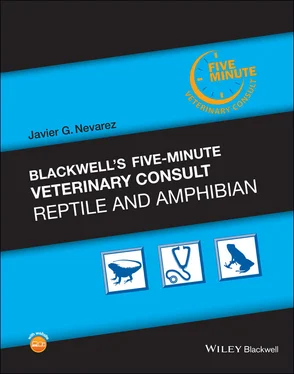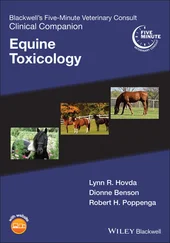Swelling in the area of the neck and/or peripheral edema.
Presentation is similar to that seen in mammals.
Some differences exist due to differing cardiovascular physiology and anatomy.
Non‐specific clinical signs such as lethargy, depression, anorexia, weight loss, weakness, dyspnea, bilateral exophthalmia, and sudden death.
Cyanosis
Peripheral edema (e.g., in gular region)
Pulmonary edema, ascites
Neurological signs such as ataxia and head tilt in case of brain anoxia.
Peripheral thrombosis and necrosis in case of filarial infestation of the cardiovascular system.
Coughing is not a feature of congestive heart failure as observed in mammals.
Inadequate husbandry, resulting in chronic stress, immune suppression and malnutrition, is the most likely common predisposing factor for the development of cardiovascular conditions in captive reptiles.
Atherosclerosis and viral diseases can also be predisposing factors.
 DIAGNOSIS
DIAGNOSIS
DIFFERENTIAL DIAGNOSIS
All other diseases that induce lethargy and/ or respiratory distress.
Ambient temperature can influence cardiopulmonary parameters in reptiles so must be considered during examination.
The use of a stethoscope is impossible because of the osteodermic shell.
A continuous Doppler ultrasonic probe (8 MHz) can also be used for cardiac “auscultation”. It allows determination of heart rate and rhythm but only indicates blood flow (not valve closure).
The most practical diagnostic tool for antemortem evaluation of reptilian heart diseases.
Allows visualization of blood flow within the heart. In chelonians, the transducer is placed in the cervicobrachial area.
Hematology and Biochemistry
Blood pressure measurement and pulse oximetry are not reliable in reptiles.
CK and LDH may increase with conditions affecting the cardiac muscle in reptiles, such as myocarditis or infarct. However, these are non‐specific measurements and may also increase with skeletal muscle damage from traumatic injuries, loss of body condition, and intramuscular injections.
Currently, cardiac troponins have not been assessed in chelonians.
Leukocytosis, lymphocytosis, and heterophilia may be present, and are suggestive of underlying infections or hematopoietic neoplasia with secondary cardiac effects.
Low electric amplitudes (usually < 1.0 mV) and standard parameters not established for many species.
Common findings in the normal reptilian ECG include P‐wave pleomorphism, very small Q and S deflections and prolonged Q‐T intervals compared with similar‐ sized mammals.
Correct electrode placement (challenging in reptiles) is essential to avoid erroneous ECG readings.
Challenging to produce images of high diagnostic value, especially in chelonians.
Apart from obvious cardiomyopathy, neither CT nor MRI (unless using a very high magnetic field strengths) are of use for visualizing intracardiac structures and large vessels.
Evaluate for concurrent disease to determine whether cardiac issue is primary or secondary (neoplastic, infectious).
Gross and histopathologic findings depend on the type of heart disease.
 TREATMENT
TREATMENT
APPROPRIATE HEALTH CARE
Little information
The pharmacology of cardiac drugs in reptiles is poorly understood and few data are available in the literature (pharmacokinetics, toxicity, etc.).
No specific nutritional support considerations or recommendations.
CLIENT EDUCATION/HUSBANDRY RECOMMENDATIONS
Reduce stress by minimizing handling, separating from cage mates, and maintaining the reptile at its preferred optimum temperature.
 MEDICATIONS
MEDICATIONS
DRUG(S) OF CHOICE
Beta‐blockers: of unknown effectiveness in reptile patients.
Methylatropine: administration results in an increase in resting heart rate of iguanas (Iguana iguana). No data available for chelonians.
Pimobendan and digoxin: unknown effects in reptiles.
Enalapril: inhibited angiotensin I conversion in alligators at 0.5–0.7 mg/kg once every 24 hours (combined with spironolactone and furosemide). No data available for chelonians.
Furosemide: possible diuretic effect in chelonians despite lacking the loop of Henle.
Hydrochlorothiazide has been used as a diuretic in lizards with renal disease. No data available for chelonians.
Methylated xanthines (aminophylline and theophylline) have successfully induced diuresis.
Nothing is known about the potential use of spironolactone in reptiles.
N/A
 FOLLOW‐UP
FOLLOW‐UP
PATIENT MONITORING
Hemoculture, repeated echocardiographic examinations
EXPECTED COURSE AND PROGNOSIS
As no specific treatment is available, fast deterioration can be expected.
 MISCELLANEOUS
MISCELLANEOUS
COMMENTS
N/A
Can be zoonotic in case of salmonellosis and other Gram‐negative bacteria.
Cardiovascular disease
Heart disease
CK = creatine kinase
CT = computed tomography
ECG = electrocardiogram
LDH = lactate dehydrogenase
MRI = magnetic resonance imaging
1 Beaufrère H, Schilliger L, Pariaut R. Cardiovascular system. In: Mitchell MA, Tully TN, eds. Current Therapy of Exotic Animal Practice. St. Louis, MO: Elsevier; 2016:151–220.
2 Mitchell MA. Reptile cardiology. Vet Clin
3 North Am Exot Anim Pract 2009;12:65–79. Schilliger L, Girling S. Cardiology. In:
4 Divers S, Stahl S, eds. Mader’s Reptile and Amphibian Medicine and Surgery. St. Louis, MO: Elsevier; 2019:669–698.
AuthorLionel Schilliger, DVM, DECZM (Herpetology), DABVP (Reptile & Amphibian Practice)
Cloacal Prolapse
 BASICS
BASICS
Читать дальше

 DIAGNOSIS
DIAGNOSIS TREATMENT
TREATMENT MEDICATIONS
MEDICATIONS FOLLOW‐UP
FOLLOW‐UP MISCELLANEOUS
MISCELLANEOUS BASICS
BASICS










